Ecosystem Health Assessment and Zoning at the County Scale: Evidence from Fujian, Southern China’s Key Forest Region
Abstract
1. Introduction
2. Materials and Methods
2.1. Study Area
2.2. Research Framework Construction
2.3. VORS-Based EH Assessment Model
2.3.1. EV
2.3.2. EO
2.3.3. ER
2.3.4. ES
2.4. Spatial Autocorrelation Model
2.5. Data Sources
3. Results and Discussion
3.1. The Overall Changes in the Constituent Indicators of EH
3.1.1. Changes in EV
3.1.2. Changes in EO
3.1.3. Changes in ER
3.1.4. Changes in ES
3.1.5. Characteristics of Spatial Variability in Sub-Indicators of Ecosystem Health
3.2. Temporal and Spatial Dynamics of EH in Fujian Province
3.3. Spatial Clustering of EHI
3.4. Ecological Management Zones and Optimization Strategies
- (1)
- For Ecological Conservation Area (Type III-3): This sub-type accounts for 41.86% of all counties, mainly distributed in the western and northern parts of Fujian Province, where EH conditions are generally favorable. These areas demonstrate high levels of EV, EO, ER, and ES, underscoring their role as ecological strongholds. The primary management objective in conservation zones should be to safeguard the authenticity and integrity of ecosystems. Strict protection measures and minimization of anthropogenic disturbance can enhance ecosystem regulation and restoration capacities, improve resilience to external pressures, and secure biodiversity and long-term service provision. Natural restoration should serve as the core strategy, supported by scientific forest management practices to improve forest quality. In addition, the establishment of multi-dimensional ecological corridors is recommended to strengthen landscape connectivity and biodiversity protection, thereby consolidating their function as critical ecological barriers.
- (2)
- For Ecological Stability Zone (Types I-3 and II-2): This zone accounts for 20.93% of the total counties and is mainly distributed in the central region of Fujian Province. Ecosystems in these areas exhibit high vitality, strong service capacity, well-structured organization, above-average resilience, rich biodiversity, and robust self-restoration potential. Management should prioritize strengthening natural regenerative capacity and optimizing the spatial configuration of ecological elements to maintain long-term stability. Key measures include forest restoration, landscape pattern optimization, and biodiversity enhancement to reinforce ecosystem self-recovery mechanisms. At the same time, the rational use of green resources should be promoted without compromising ecological integrity. Limited, low-intensity development activities may be allowed, provided they are compatible with ecological protection objectives and support sustainable regional development.
- (3)
- For Ecological Reshaping Zone (Types I-1, I-2, and II-1): This zone constitutes 37.20% of the counties and is mainly distributed in the southern and eastern regions of Fujian Province. Due to intensive human activities—particularly in the southeastern coastal areas—ecosystems in this zone have experienced significant degradation, diminished ecological functions, and weakened self-repair capacity. The management priority should therefore focus on ecological restoration and reconstruction, supported by appropriate human intervention and scientific planning. Active measures such as vegetation restoration, soil improvement, and land use optimization are essential to restore ecosystem functions, enhance structural stability, and promote recovery. In parallel, efforts should be directed toward reducing unsustainable development, strengthening ecological monitoring, and ensuring the long-term effectiveness of restoration projects. Practical experiences in southeastern Fujian underscore the feasibility of such approaches. For instance, the “Retreat from Aquaculture and Restore Wetlands” program in Xiamen and Quanzhou Bays successfully converted large areas of aquaculture ponds into mangroves and natural wetlands, significantly enhancing coastal resilience, biodiversity, and ecological buffering capacity. Similarly, hillside afforestation in Jiaocheng District combined reforestation with erosion control, improving vegetation cover, soil stability, and landscape connectivity. Together, these cases demonstrate how targeted ecological reshaping strategies can progressively restore ecosystem health and support regional sustainable development.
3.5. Model Strengths, Similarities and Differences with Other Studies
3.6. Shortcomings and Prospects
- (1)
- Although this study employed four representative ecosystem services—carbon sequestration, soil conservation, water yield, and food provisioning—to capture key regulating and provisioning functions, the framework remains incomplete. Cultural services were not included due to difficulties in quantification. In particular, at the county scale in China, relevant cultural indicators are often statistically incomplete and lack uniform standards, which constrains their reliable measurement. Future research should address these limitations by incorporating proxy indicators, such as the frequency of cultural events and participatory survey data, to improve the assessment of cultural services.
- (2)
- The current VORS-based assessment framework, while structurally comprehensive, still relies on expert judgment for assigning weights and thresholds to core indicators (ecological vitality, organizational structure, resilience, and service function). The absence of a unified standard and data-driven calibration may affect regional comparability and limit broader applicability. To address this, future studies could incorporate machine learning approaches (e.g., random forests, Bayesian networks) to dynamically optimize indicator weights using spatiotemporal big data. Furthermore, developing a standardized toolkit based on ecological baselines and pressure thresholds would enable the construction of differentiated parameter systems tailored to distinct geographic regions.
- (3)
- The ecological zoning scheme proposed in this study offers valuable theoretical guidance for regional EH management. However, its practical implementation requires further refinement. Future work should integrate analyses of land use conflicts, socio-economic heterogeneity, and policy implementation costs to design and test more detailed management strategies. Land use simulation models such as CLUE-S and PLUS can be employed for multi-scenario simulations to quantify ecological impacts under alternative development pathways. Additionally, market-based instruments, such as eco-banking, could be explored in reshaping zones to enhance policy precision and incentive effectiveness.
4. Conclusions
- (1)
- Between 2000 and 2020, the EHI of counties in Fujian Province remained at a relatively high level and exhibited a clear upward trajectory, rising from 0.4694 in 2000 to 0.4762 in 2010, and further increasing to 0.4865 by 2020.
- (2)
- Fujian’s EHI shows significant spatial autocorrelation and clustering, predominantly with high–high and low–low clusters, and overall follows a spatial pattern of higher values in the northwest and lower values in the southeast.
- (3)
- This study categorizes the counties of Fujian Province into three ecological management zones—ecological conservation zones, ecological stability zones, and ecological restoration zones—based on the current status and trends of EHI. It proposes specific, targeted management strategies tailored to the characteristics of each zone, intending to offer theoretical references and practical insights for future ecological management policies in Fujian Province.
Author Contributions
Funding
Data Availability Statement
Conflicts of Interest
References
- Qu, H.; You, C.; Feng, C.; Guo, L. The spatial spillover effects of ecosystem services: A case study in Yangtze River economic belt in China. Ecol. Indic. 2024, 168, 112741. [Google Scholar] [CrossRef]
- Chen, F.; Chen, W.; Qiu, H. Poverty alleviation resettlement in China reduces deforestation. Proc. Natl. Acad. Sci. USA 2025, 122, e2421526122. [Google Scholar] [CrossRef]
- Mansori, M.; Badehian, Z.; Ghobadi, M.; Maleknia, R. Assessing the environmental destruction in forest ecosystems using landscape metrics and spatial analysis. Sci. Rep. 2023, 13, 15165. [Google Scholar] [CrossRef]
- Hýsek, Š.; Löwe, R.; Turčáni, M. What Happens to Wood after a Tree Is Attacked by a Bark Beetle? Forests 2021, 12, 1163. [Google Scholar] [CrossRef]
- Wang, X.; Dong, Q. Assessment of urban ecosystem health and its influencing factors: A case study of Zibo City, China. Sci. Rep. 2024, 14, 8455. [Google Scholar] [CrossRef] [PubMed]
- He, J.; Pan, Z.; Liu, D.; Guo, X. Exploring the regional differences of ecosystem health and its driving factors in China. Sci. Total Environ. 2019, 673, 553–564. [Google Scholar] [CrossRef]
- Chen, W.; Gu, T.; Zeng, J. Urbanisation and ecosystem health in the Middle Reaches of the Yangtze River urban agglomerations, China: A U-curve relationship. J. Environ. Manag. 2022, 318, 115565. [Google Scholar] [CrossRef] [PubMed]
- Chen, W.; Gu, T.; Xiang, J.; Luo, T.; Zeng, J.; Yuan, Y. Ecological restoration zoning of territorial space in China: An ecosystem health perspective. J. Environ. Manag. 2024, 364, 121371. [Google Scholar] [CrossRef]
- Pan, Z.; He, J.; Liu, D.; Wang, J.; Guo, X. Ecosystem health assessment based on ecological integrity and ecosystem services demand in the Middle Reaches of the Yangtze River Economic Belt, China. Sci. Total Environ. 2021, 774, 144837. [Google Scholar] [CrossRef]
- Du, W.; Liao, X.; Tong, Z.; Rina, S.; Rong, G.; Zhang, J.; Guo, E. Early warning and scenario simulation of ecological security based on DPSIRM model and Bayesian network: A case study of east Liaohe river in Jilin Province, China. J. Clean. Prod. 2023, 398, 136649. [Google Scholar] [CrossRef]
- Shen, W.; Li, Y.; Qin, Y. Research on the influencing factors and multi-scale regulatory pathway of ecosystem health: A case study in the Middle Reaches of the Yellow River, China. J. Clean. Prod. 2023, 406, 137038. [Google Scholar] [CrossRef]
- Zhao, C.; Shao, N.; Yang, S.; Ren, H.; Ge, Y.; Zhang, Z.; Zhao, Y.; Yin, X. Integrated assessment of ecosystem health using multiple indicator species. Ecol. Eng. 2019, 130, 157–168. [Google Scholar] [CrossRef]
- Pourchet, M.; Debrauwer, L.; Klanova, J.; Price, E.; Covaci, A.; Caballero-Casero, N.; Antignac, J. Suspect and non-targeted screening of chemicals of emerging concern for human biomonitoring, environmental health studies and support to risk assessment: From promises to challenges and harmonisation issues. Environ. Int. 2020, 139, 105545. [Google Scholar] [CrossRef] [PubMed]
- Li, Z.; Zhu, K.; Ba, Y.; Zhang, Y.; Yang, W.; Wang, J.; Chen, W.; Dong, C.; Qian, K.; Zhou, K. Rigidity and resilience framework-based health diagnosis of mountain forest ecosystems: A case study of Yiliang County in Yunnan Province. J. Clean. Prod. 2025, 507, 145569. [Google Scholar] [CrossRef]
- Xiao, Z.; Liu, R.; Gao, Y.; Yang, Q.; Chen, J. Spatiotemporal variation characteristics of ecosystem health and its driving mechanism in the mountains of southwest China. J. Clean. Prod. 2022, 345, 131138. [Google Scholar] [CrossRef]
- Liao, C.; Yue, Y.; Wang, K.; Fensholt, R.; Tong, X.; Brandt, M. Ecological restoration enhances ecosystem health in the karst regions of southwest China. Ecol. Indic. 2018, 90, 416–425. [Google Scholar] [CrossRef]
- Mosaffaie, J.; Jam, A.S.; Tabatabaei, M.R.; Kousari, M.R. Trend assessment of the watershed health based on DPSIR framework. Land Use Policy 2021, 100, 104911. [Google Scholar] [CrossRef]
- Cui, N.; Feng, C.-C.; Han, R.; Guo, L. Impact of Urbanization on Ecosystem Health: A Case Study in Zhuhai, China. Int. J. Environ. Res. Public Health 2019, 16, 4717. [Google Scholar] [CrossRef]
- Xie, X.; Fang, B.; Xu, H.; He, S.; Li, X. Study on the coordinated relationship between Urban Land use efficiency and ecosystem health in China. Land Use Policy 2021, 102, 105235. [Google Scholar] [CrossRef]
- He, R.; Huang, X.; Ye, X.; Pan, Z.; Wang, H.; Luo, B.; Liu, D.; Hu, X. County Ecosystem Health Assessment Based on the VORS Model: A Case Study of 183 Counties in Sichuan Province, China. Sustainability 2022, 14, 11565. [Google Scholar] [CrossRef]
- Li, K.; Hou, Y.; Fu, Q.; Randall, M.; Andersen, P.; Qiu, M.; Skov-Petersen, H. Integrating decision-making preferences into ecosystem service conservation area identification: A case study of water-related ecosystem services in the Dawen River watershed, China. J. Environ. Manag. 2023, 340, 117972. [Google Scholar] [CrossRef]
- Han, P.; Hu, H.; Zhou, J.; Wang, M.; Zhou, Z. Integrating key ecosystem services to study the spatio-temporal dynamics and determinants of ecosystem health in Wuhan’s central urban area. Ecol. Indic. 2024, 166, 112352. [Google Scholar] [CrossRef]
- Li, Y.; Qin, L.; Wang, Y.; Liu, H.; Zhang, M.; Hao, H. Ecosystem health assessment of the largest lake wetland in the Yellow River basin using an improved vigor-organization-resilience-services model. Ecol. Indic. 2024, 166, 112539. [Google Scholar] [CrossRef]
- Wu, Y.; Wu, Y.; Li, C.; Gao, B.; Zheng, K.; Wang, M.; Deng, Y.; Fan, X. Spatial Relationships and Impact Effects between Urbanization and Ecosystem Health in Urban Agglomerations along the Belt and Road: A Case Study of the Guangdong-Hong Kong-Macao Greater Bay Area. Int. J. Environ. Res. Public Health 2022, 19, 16053. [Google Scholar] [CrossRef]
- Wang, P.; Zhang, J.; Xu, D.; Chen, D.; Tao, J.; Wang, J.; Ma, X. Study on driving factors of island ecosystem health and multi-scenario ecology simulation using ecological conservation and eco-friendly tourism for achieving sustainability. J. Environ. Manag. 2025, 373, 123480. [Google Scholar] [CrossRef]
- Bai, Y.; Wong, C.; Jiang, B.; Hughes, A.; Wang, M.; Wang, Q. Developing China’s Ecological Redline Policy using ecosystem services assessments for land use planning. Nat. Commun. 2018, 9, 3034. [Google Scholar] [CrossRef]
- Lyu, R.; Clarke, K.; Tian, X.; Zhao, W.; Pang, J.; Zhang, J. Land use zoning management to coordinate the supply–demand imbalance of ecosystem services: A case study in the city belt along the yellow river in Ningxia, China. Front. Environ. Sci. 2022, 10, 911190. [Google Scholar] [CrossRef]
- Huang, J.; Yang, S.; Zhu, W.; Lin, J.; Zhu, Y.; Ren, J.; Zhang, A. Spatial and temporal characterization of critical ecosystem services in China’s terrestrial area, 2000–2020: Trade-off synergies, driving mechanisms and functional zoning. Front. Ecol. Evol. 2024, 12, 1443683. [Google Scholar] [CrossRef]
- Zhu, W.; Huang, J.; Yang, S.; Liu, W.; Dai, Y.; Huang, G.; Lin, J. Spatiotemporal Evolution, Driving Mechanisms, and Zoning Optimization Pathways of Ecosystem Health in China. Forests 2024, 15, 1987. [Google Scholar] [CrossRef]
- Ran, C.; Wang, S.; Bai, X.; Tan, Q.; Wu, L.; Luo, X.; Lu, Q. Evaluation of temporal and spatial changes of global ecosystem health. Land Degrad. Dev. 2021, 32, 1500–1512. [Google Scholar] [CrossRef]
- Lv, T.; Zeng, C.; Lin, C.; Liu, W.; Cheng, Y.; Li, Y. Towards an integrated approach for land spatial ecological restoration zoning based on ecosystem health assessment. Ecol. Indic. 2023, 147, 110016. [Google Scholar] [CrossRef]
- Hernández-Blanco, M.; Costanza, R.; Chen, H.; DeGroot, D.; Jarvis, D.; Kubiszewski, I.; Montoya, J.; Sangha, K.; Stoeckl, N.; Turner, K.; et al. Ecosystem health, ecosystem services, and the well-being of humans and the rest of nature. Glob. Change Biol. 2022, 28, 5027–5040. [Google Scholar] [CrossRef]
- Wu, C.; Chen, W. Indicator system construction and health assessment of wetland ecosystem—Taking Hongze Lake Wetland, China as an example. Ecol. Indic. 2020, 112, 106164. [Google Scholar] [CrossRef]
- Liu, P.; Rong, L.; Teng, F. The evaluation of ecosystem health based on hybrid TODIM method for Chinese case. Technol. Econ. Dev. Econ. 2019, 25, 542–570. [Google Scholar] [CrossRef]
- Liu, R.R.; Dong, X.B.; Wang, X.C.; Zhang, P.; Liu, M.X.; Zhang, Y. Relationship and driving factors between urbanization and natural ecosystem health in China. Ecol. Indic. 2023, 147, 109972. [Google Scholar] [CrossRef]
- Xu, X.; Yang, G.; Tan, Y.; Liu, J.; Hu, H. Ecosystem services trade-offs and determinants in China’s Yangtze River Economic Belt from 2000 to 2015. Sci. Total Environ. 2018, 634, 1601–1614. [Google Scholar] [CrossRef]
- Ouyang, Z.; Zheng, H.; Xiao, Y.; Polasky, S.; Liu, J.; Xu, W.; Daily, G. Improvements in ecosystem services from investments in natural capital. Science 2016, 352, 1455–1459. [Google Scholar] [CrossRef]
- Huang, C.; Zhao, D.; Liao, Q.; Xiao, M. Linking landscape dynamics to the relationship between water purification and soil retention. Ecosyst. Serv. 2023, 59, 101498. [Google Scholar] [CrossRef]
- Wang, F.; Wu, Y.; Zhang, Y.; Wang, J.; Xue, Z.; Tan, X.; Jia, W. Research on ecosystem service value and landscape ecological risk prediction and zoning: Taking Fujian province as an example. Ecol. Mod. 2025, 507, 111173. [Google Scholar] [CrossRef]
- Wang, Z.; Tang, L.; Qiu, Q.; Chen, H.; Wu, T.; Shao, G. Assessment of Regional Ecosystem Health—A Case Study of the Golden Triangle of Southern Fujian Province, China. Int. J. Environ. Res. Public Health 2018, 15, 802. [Google Scholar] [CrossRef]
- Zheng, P.; Jin, L.; Huang, Y.; Pan, W. Spatial and Temporal Dynamic Evolution and Correlation of Ecological Quality and Ecosystem Service Value in Fujian Province. Sustainability 2024, 16, 5063. [Google Scholar] [CrossRef]
- Li, X.; Fan, Z.; Sha, J.; Sha, J.; Guo, X.; Zheng, C.; Shifaw, E.; Wang, J. The comparative study of urban ecosystem health change in Asian and African coastal cities—Changle in China and Suez in Egypt. Ecol. Indic. 2024, 159, 111648. [Google Scholar] [CrossRef]
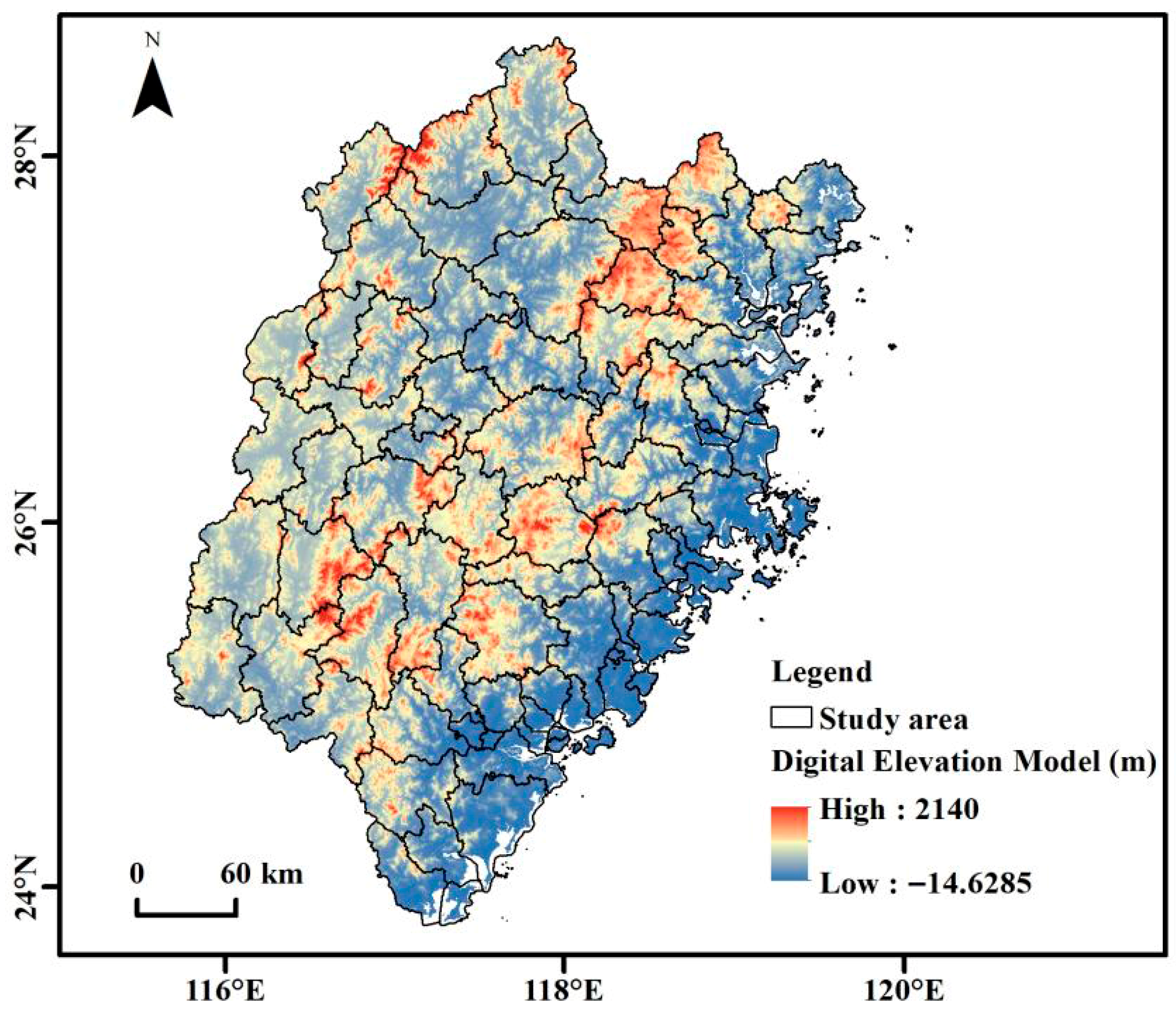
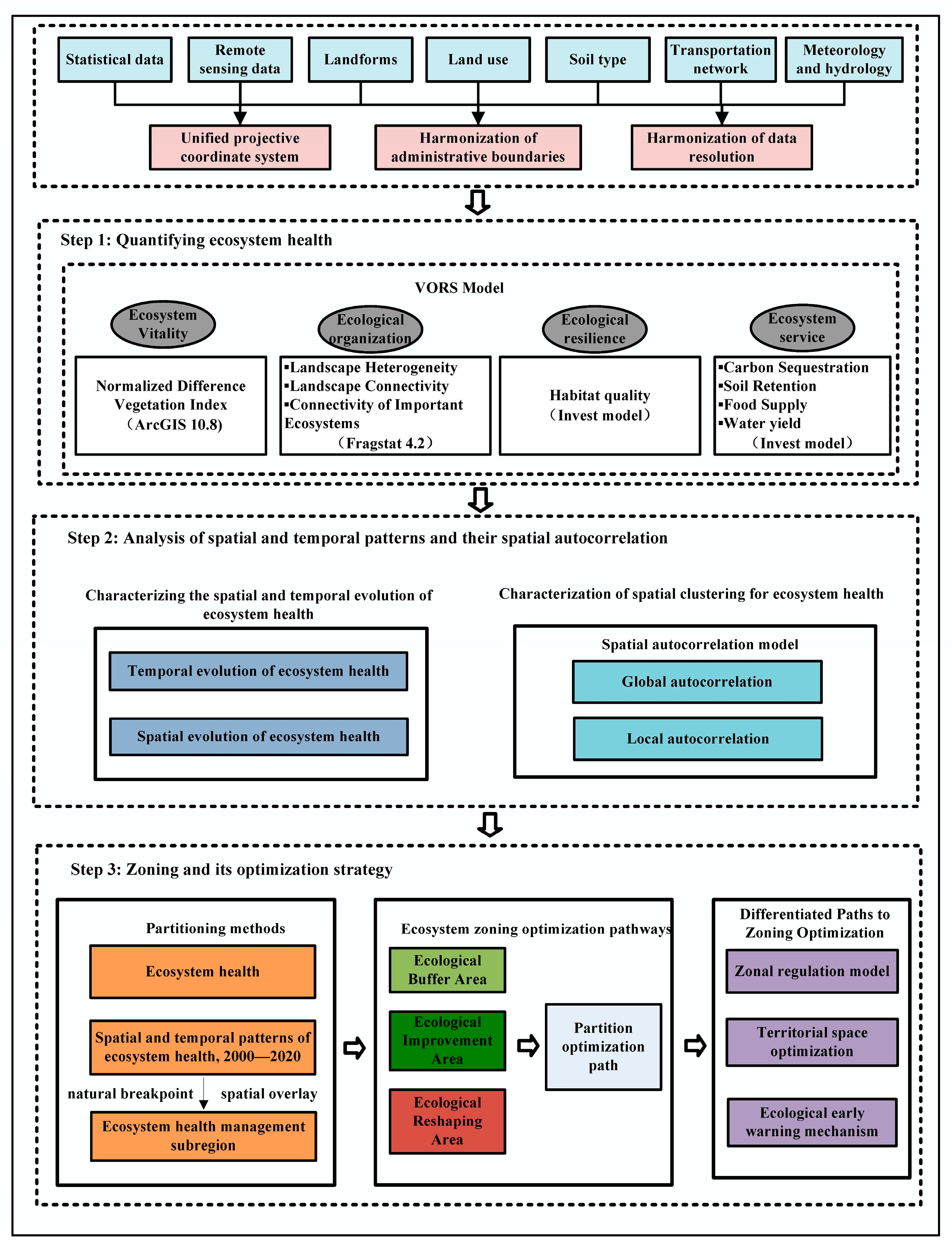
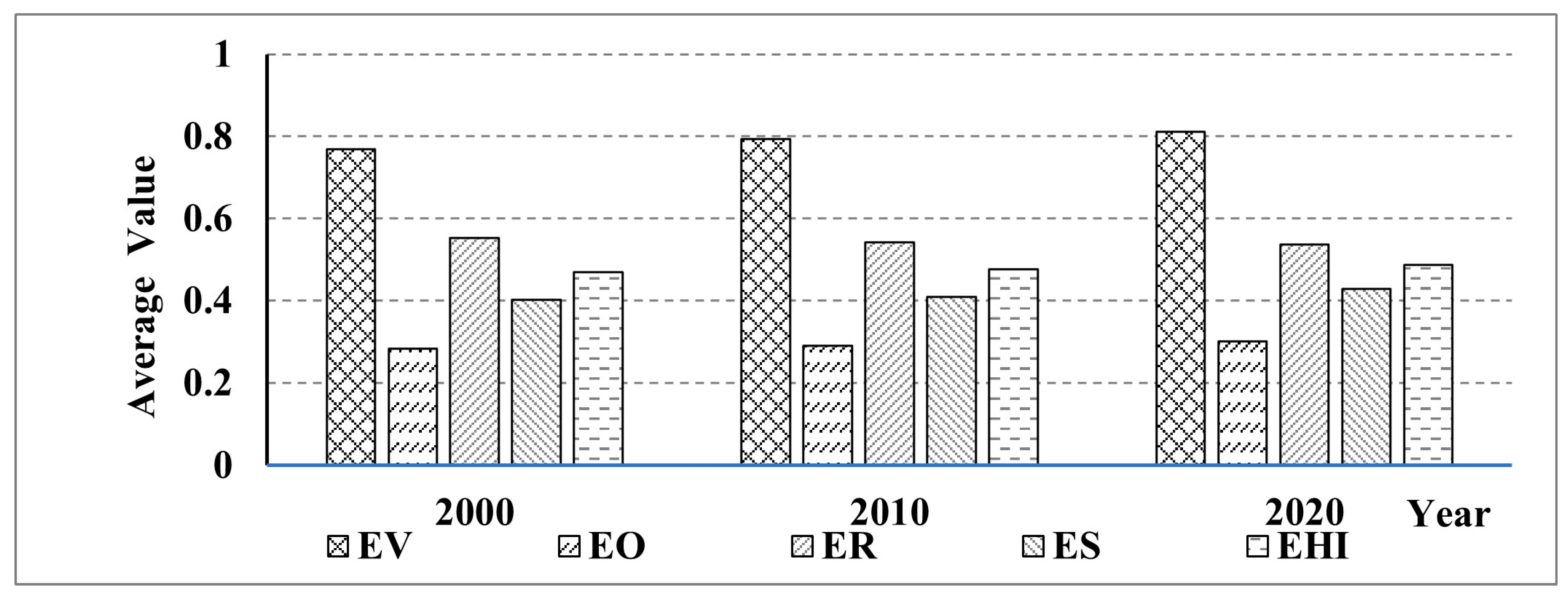
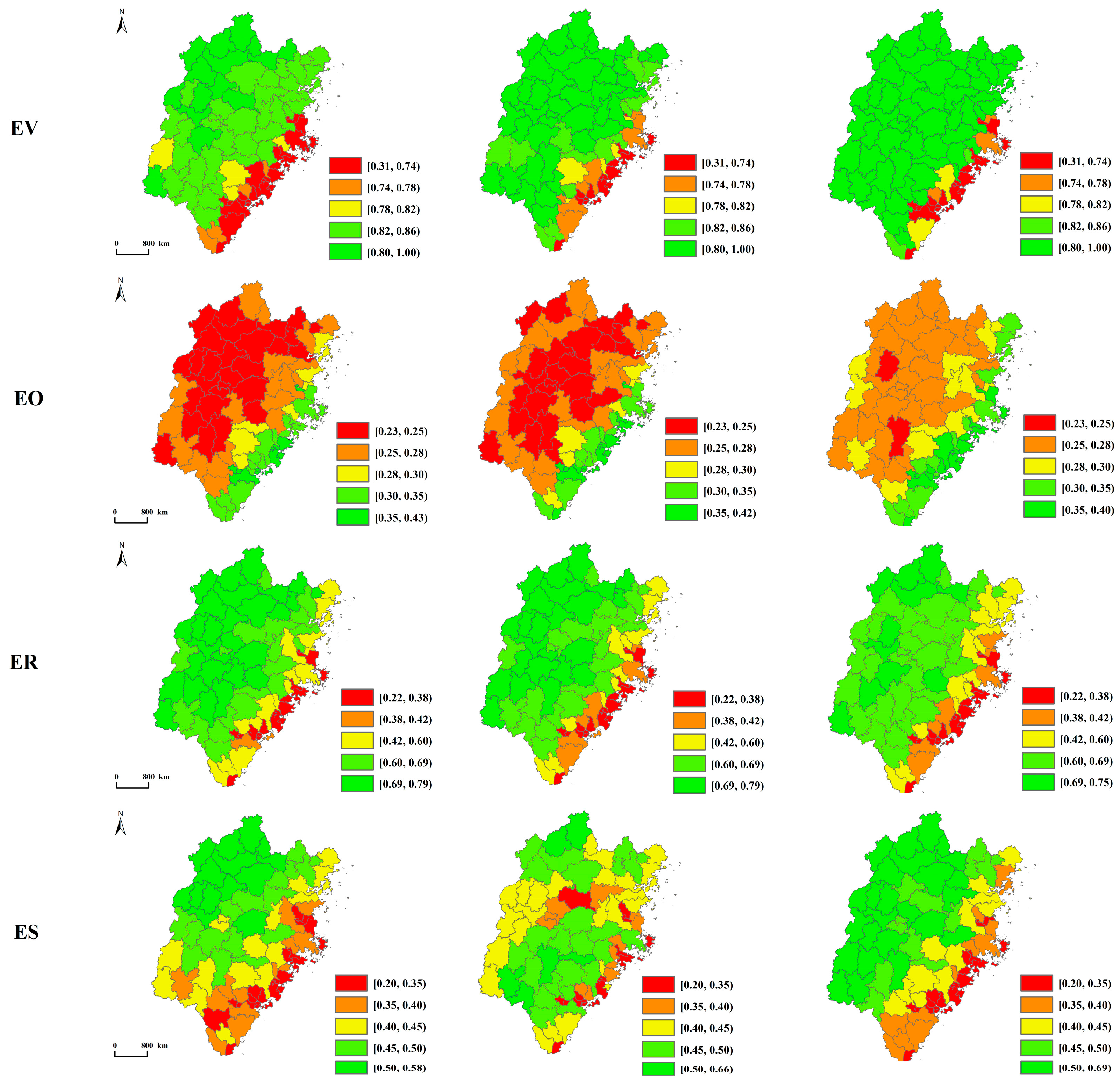


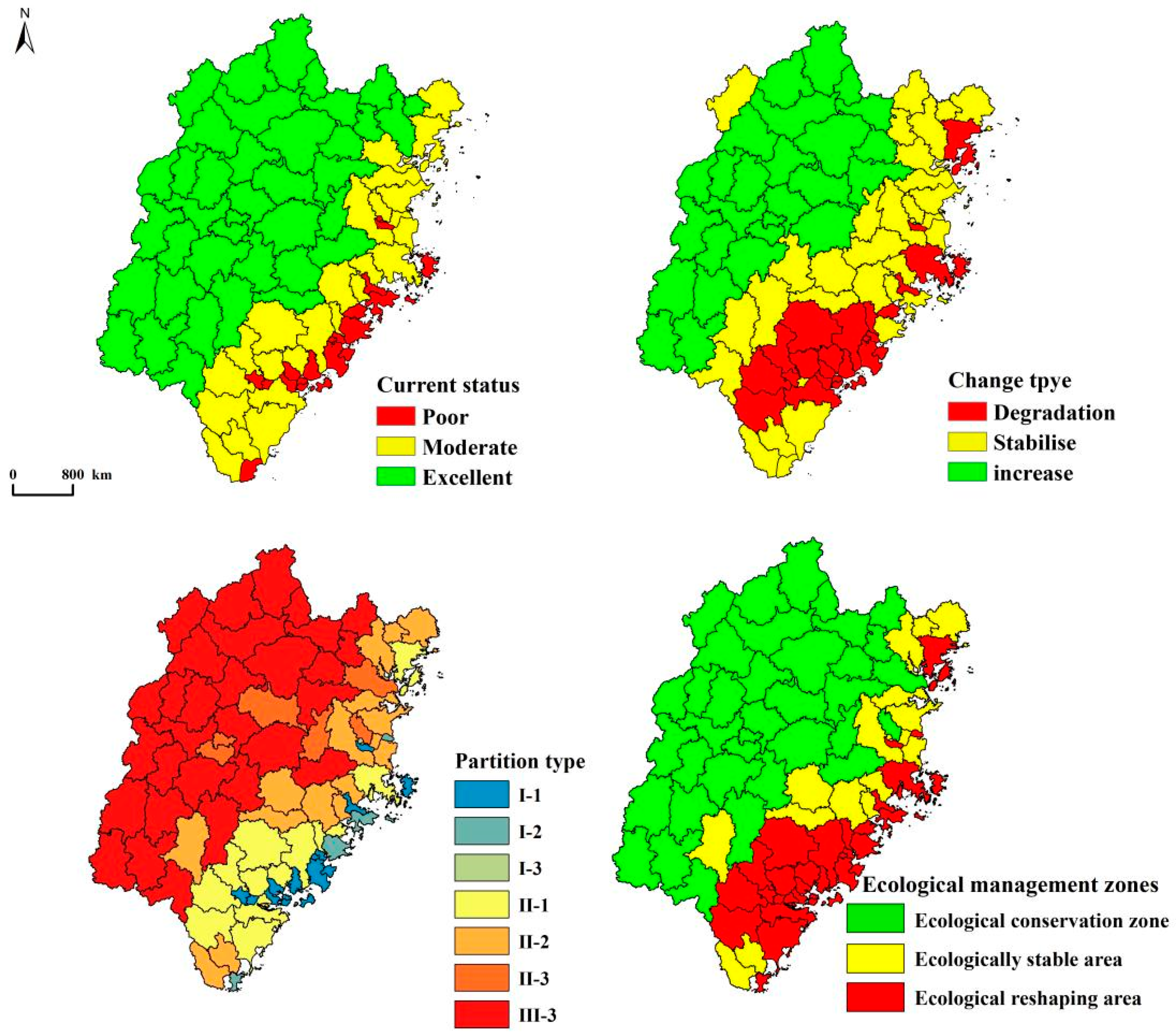
| ES Type | Calculation Method | Formula |
|---|---|---|
| sequestration | The research performed a comprehensive assessment of carbon sequestration across four principal carbon reservoirs: Subterranean biomass, aerial biomass, necromass, and edaphic organic matter. The total regional carbon storage was methodically calculated by utilizing the average carbon density and the area associated with each land use/cover type [37]. | |
| where CStotal denotes the total ecosystem carbon storage; CSabove refers to above ground carbon storage; CSbelow indicates below ground carbon storage; CSsoil stands for soil carbon storage; and CSdead represents the carbon storage in dead organic matter. | ||
| Soil conservation | This study utilized the revised Universal Soil Loss Equation (USLE) model to evaluate the present and potential soil erosion levels in the region. By calculating the difference between the two, a spatially explicit quantitative assessment of regional soil retention was achieved [38]. | |
| Aa = Ri × Ki × LSi × Ci × Pi | ||
| In this equation, As denotes the amount of soil retained per unit area (t/(hm2·a)); Aa and Ap are the actual and potential soil erosion per unit area (t/(hm2·a)), respectively. Ri is the rainfall erosivity factor for the i-th grid cell (MJ mm hm−2 h−1); Ki indicates the soil erodibility factor; Si and Li represent coefficients for slope gradient and slope length. Meanwhile, Ci and Pi represent vegetation cover management factors and protective practice factors. | ||
| Grain supply | The regional food supply function is closely tied to food production, playing a vital role in ensuring food security and advancing regional sustainable development [39]. This research, utilizing county-level grain yield, land distribution, and NDVI data from Fujian Province, uncovers the spatial distribution characteristics of food supply functions between 2000 and 2020, with a spatial resolution of 30 m. | |
| In the equation: Fi refers to the total grain production of the i-th grid unit; NDVIi is the NDVI value of the i-th grid cell on cultivated land; NDVIsum refers to the total sum of NDVI values for the cultivated land within a particular county-level unit. Fsum is the total grain output of the county. | ||
| Water yield | The representation of water yield capacity was based on the principle of water balance, calculated as the difference between precipitation and actual evapotranspiration at the grid-cell level. The settings and selection of key parameters, such as potential and actual evapotranspiration, were determined with reference to previous studies [29] and the InVEST model user guide to ensure scientific rigor and comparability of the results. | |
| where Wi represents the water yield of grid cell i, indicating its potential water conservation capacity; AETi denotes the annual actual evapotranspiration of grid cell i; and P(i) refers to the annual precipitation of grid cell i. |
| Data Type | Index | Year | Resolution Ratio/m | Data Source |
|---|---|---|---|---|
| Land use | Types of land use | 2000, 2010, 2020 | 30 | China Land Cover Dataset, CLCD (https://zenodo.org/record/8176941, accessed on 16 August 2025) [3] |
| Administrative division | Provincial and county-level administrative divisions | 2020 | / | Chinese Academy of Sciences Resource and Environmental Science Data Center (http://www.resdc.cn, accessed on 17 May 2025) [29] |
| Vegetational coverage | Normalized Difference Vegetation Index (NDVI) | 2000, 2010, 2020 | 30 | Chinese Academy of Sciences Resource and Environmental Science Data Center (http://www.resdc.cn, accessed on 17 May 2025) [6] |
| Soil status | Soil texture | 2019 | 1 000 | World Soil Database of the National Tibetan Plateau Data Center (HWSD) Soil dataset (https://data.tpdc.ac.cn, accessed on 24 April 2025) [28] |
| Landforms | Digital Elevation Model (DEM) | 2020 | 30 | Geospatial Data Cloud (https://www.gscloud.cn, accessed on 12 January 2025) [15] |
| Climatic condition | Precipitation | 2000, 2010, 2020 | 30 | Monthly Dataset of Meteorological Elements Observed at Chinese Weather Stations (https://www.resdc.cn, accessed on 12 February 2025) [11] |
| Grain production | Grain yield | 2000, 2010, 2020 | / | Statistical Yearbook of China’s Counties [28] |
| Year | Number of Low Health Counties | Percentage/% | Number of Less Healthy Counties | Percentage/% | Number of Moderately Healthy Counties | Percentage/% | Number of Higher Health Counties | Percentage/% | Number of Highly Healthy Counties | Percentage/% |
|---|---|---|---|---|---|---|---|---|---|---|
| 2000 | 15 | 17.86 | 9 | 10.71 | 17 | 20.24 | 35 | 41.67 | 8 | 9.52 |
| 2010 | 20 | 23.81 | 24 | 28.57 | 25 | 29.76 | 34 | 40.48 | 16 | 19.04 |
| 2020 | 20 | 23.81 | 5 | 5.95 | 13 | 15.48 | 17 | 20.24 | 30 | 35.71 |
| Years | Moran’s Index | Z-Value | p-Value |
|---|---|---|---|
| 2000 | 0.641 | 7.848 | 0 |
| 2010 | 0.757 | 9.189 | 0 |
| 2020 | 0.776 | 9.392 | 0 |
| Type | Include Regions | Management Objective |
|---|---|---|
| Ecological conservation zones | III-3 | Leveraging the natural restoration capacity of ecosystems and integrating regional environmental features, optimize the ecological spatial structure, enhance ecological functions and biodiversity protection, and realize sustainable development. |
| Ecological enhancement zones | I-3, II-2 | Honor natural processes, allow ecosystems to evolve independently, restrict the negative effects of human activities on ecological spaces, carry out ecological restoration projects, and promote models of sustainable development. |
| Ecological reshaping zones | I-1, I-2, II-1 | In necessary cases, actively intervene through human efforts, using scientific methods to rebuild or restore damaged ecosystems, promote positive ecological succession, and enhance their function and stability. |
Disclaimer/Publisher’s Note: The statements, opinions and data contained in all publications are solely those of the individual author(s) and contributor(s) and not of MDPI and/or the editor(s). MDPI and/or the editor(s) disclaim responsibility for any injury to people or property resulting from any ideas, methods, instructions or products referred to in the content. |
© 2025 by the authors. Licensee MDPI, Basel, Switzerland. This article is an open access article distributed under the terms and conditions of the Creative Commons Attribution (CC BY) license (https://creativecommons.org/licenses/by/4.0/).
Share and Cite
Yang, S.; Huang, J.; Liu, W.; Zhuang, Y.; Lin, J.; Dai, Y. Ecosystem Health Assessment and Zoning at the County Scale: Evidence from Fujian, Southern China’s Key Forest Region. Forests 2025, 16, 1518. https://doi.org/10.3390/f16101518
Yang S, Huang J, Liu W, Zhuang Y, Lin J, Dai Y. Ecosystem Health Assessment and Zoning at the County Scale: Evidence from Fujian, Southern China’s Key Forest Region. Forests. 2025; 16(10):1518. https://doi.org/10.3390/f16101518
Chicago/Turabian StyleYang, Shuqi, Jixing Huang, Wanyi Liu, Yiqun Zhuang, Jinhuang Lin, and Yongwu Dai. 2025. "Ecosystem Health Assessment and Zoning at the County Scale: Evidence from Fujian, Southern China’s Key Forest Region" Forests 16, no. 10: 1518. https://doi.org/10.3390/f16101518
APA StyleYang, S., Huang, J., Liu, W., Zhuang, Y., Lin, J., & Dai, Y. (2025). Ecosystem Health Assessment and Zoning at the County Scale: Evidence from Fujian, Southern China’s Key Forest Region. Forests, 16(10), 1518. https://doi.org/10.3390/f16101518





